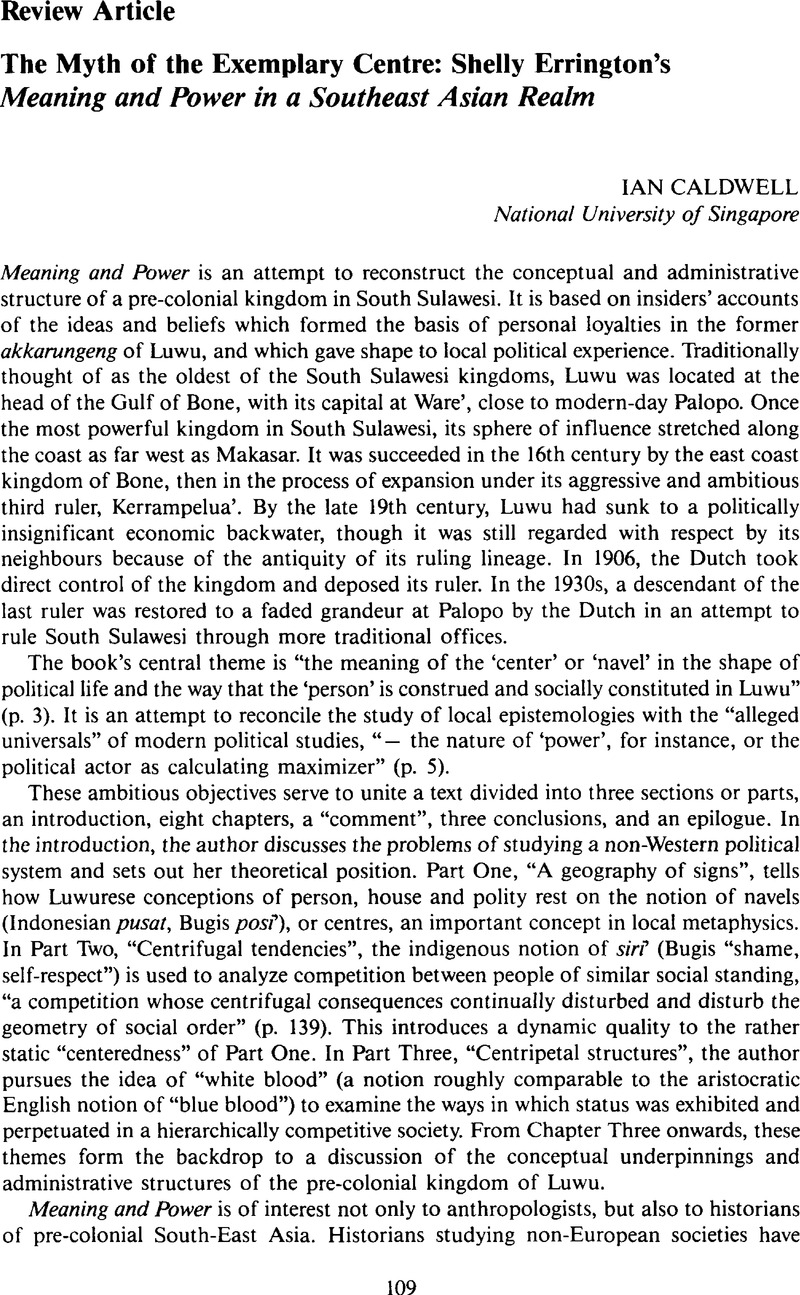Article contents
The Myth of the Exemplary Centre: Shelly Errington's Meaning and Power in a Southeast Asian Realm
Published online by Cambridge University Press: 24 August 2009
Abstract

- Type
- Review Article
- Information
- Copyright
- Copyright © The National University of Singapore 1991
References
1 Gullick, J.M., Indigenous Political Systems of Western Malaya (London: Athlone Press, 1958)Google Scholar; Milner, A.C., Kerajaan: Malay Political Culture on the Eve of Colonial Rule (Tucson: University of Arizona Press, 1982)Google Scholar; Wheatley, P., Nāgara and Commandery: Origins of the Southeast Asian Urban Traditions (Chicago: University of Chicago, 1983)Google Scholar; Drakard, J., A Malay Frontier: Unity and Duality in a Sumatran Kingdom (Ithaca: Southeast Asia Program, Cornell University, 1990)Google Scholar; Fox, J.J., Harvest of the Palm: Ecological Change in Eastern Indonesia (Cambridge, Mass.: Harvard University Press)CrossRefGoogle Scholar; Tambiah, S.J., World Conqueror and World Renouncer: A Study of Buddhism and Polity in Thailand Against a Historical Background (Cambridge: Cambridge University Press, 1976)CrossRefGoogle Scholar.
2 Geertz, C., Negara: The Theatre State in Nineteenth-Century Bali (Princeton: Princeton University Press, 1980)Google Scholar.
3 Negara, p. 13Google Scholar.
4 Indigenous Political Systems, p. 45Google Scholar.
5 Morris, Braam, van, D.F., “Het landschap Loewoe” (Tijdschrift van het Bataviaasch Genootschap van Kunsten en Wetenschappen XXXII (1889): 497–530)Google Scholar.
6 Susan Bolyard, Millar, “Bugis Society: Given by the Wedding Guest” (Doctoral dissertation, Cornell University, Ithaca, 1981)Google Scholar.
7 Andaya, L.Y., The Heritage of Arung Palakka: A History of South Sulawesi (Celebes) in the Seventeenth Century (The Hague: M. Nijhoff, 1981)Google Scholar.
8 Wolhoff, G.J. and Abdurrahim, (eds.), Sedjarah Goa (Ujung Pandang: Yayasan Sulawesi Selatan dan Tenggara, n.d.), p. 9Google Scholar.
9 Stutley, M. & Stutley, J., A Dictionary of Hinduism: Its Mythology, Folklore and Development 1500 b.c.–a.d. 1500 (London: Routledge and Kegan Paul, 1977), p. 260Google Scholar; Wolters, O.W., History, Culture and Region in Southeast Asian Perspectives (Singapore: Institute of Southeast Asian Studies, 1982), Chapter IIGoogle Scholar.
10 See, for example, Macknight, C.C., “The Emergence of Civilization in South Celebes and Elsewhere”, in Reid, A. and Castles, L. (eds.), Pre-Colonial State Systems of Southeast Asia (Kuala Lumpur: Malaysian Branch of the Royal Asiatic Society, 1975)Google Scholar and Abidin, Zainal, Persepsi Orang Bugis, Makasar Tentang Hukum, Negara dan Dunia Lain (Bandung: Penerbit Alumni, 1983), p. 209Google Scholar.
11 Coedès, G., The Indianized States of Southeast Asia (Canberra: Australian National University Press, 1968), pp. 15–16Google Scholar.
12 Stutley, , Dictionary, p. 58Google Scholar.
13 Andaya, , Heritage, p. 43Google Scholar.
14 Stutley, , Dictionary, p. 58Google Scholar.
15 Gonda, , Sanskrit in Indonesia (Nagpur: International Academy of Indian Culture, 1952), pp. 38–45Google Scholar.
16 Ras, J.J., Hikayat Bandjar: A Study in Malay Historiography (The Hague: M. Nijhoff, 1968), Chapter IVGoogle Scholar.
17 Noorduyn, J., “Origins of South Sulawesi Historical Writing”, in Soedjatmoko, et al. (eds.), An Introduction to Indonesian Historical Writing (Ithaca: Cornell University Press, 1965), pp. 137–38Google Scholar.
18 Caldwell, I.A., “Power, State and Society in Pre-Islamic South Sulawesi”, in Acciaioli, G. and van Dijk, C. (eds.), Authority and Leadership in South Sulawesi (Leiden: Foris, forthcoming)Google Scholar.
19 Macknight, , “Emergence”, p. 129Google Scholar.
20 Bellwood, P., Prehistory of the Indo-Malaysian Archipelago (Sydney: Academic Press, 1985), p. 109Google Scholar.
21 Anderson, B.R.O'G., “The Idea of Power in Javanese Culture”, in Holt, C. (ed.), Culture and Politics in Indonesia (Ithaca: Cornell University Press, 1972)Google Scholar.
22 Anderson, , “Power”, p. 22Google Scholar.
23 Anderson, , “Power”, p. 2Google Scholar.
24 Geertz, , Negara, p. 24Google Scholar.
25 Caldwell, , “Power”Google Scholar.
26 Matthes, B.F., Kort verslag aangaande alle mij in Europa bekende Makassaarsche en Boeginesche handschriften vooral die van het Nederlandsch Bijbelgenootschap te Amsterdam (Amsterdam: Nederlandsch Bijbelgenootschap, 1875)Google Scholar.
27 Macknight, C.C., “The Rise of Agriculture in South Sulawesi Before 1600”, Review of Indonesian and Malaysian Affairs 17 (1983): 92–116Google Scholar.
28 I am grateful to Mr. Ian Vail for this information.
29 MS. NBG 100, Leiden University Library, p. 63.
30 Morris, Braam, “Landschap”, p. 499Google Scholar.
31 Heine-Geldern, R., Conceptions of State and Kingship in Southeast Asia (Ithaca: Cornell University Southeast Asia Program Data Paper No. 18, 1956), p. 10Google Scholar.
32 MS NBG 127, Leiden University Library, pp. 41–45.
33 Kern, , “Boegineesche scheppingsverhalen”, in Feestbundel uitgegeven door het Koninklijk Bataviaasch Genootschap van Kunsten en Wetenschappen bij gelegenheid van zijn 150 jarig bestaan, 1778–1928 (Weltevreden: Legatum Warneranium, 1929)Google Scholar.
34 Matthes, B.F., Boegineesch-Hollandsch woordenboek, met Hollandsch-Boegineesche woordenlijst, en verklaring van een tot opheldering bijgevoegden ethnographischen atlas (Amsterdam: Nederlandsch Bijbelgenootschap, 1874)Google Scholar.
35 Cf. Anderson, , “Power”, pp. 13–19Google Scholar.
- 7
- Cited by


